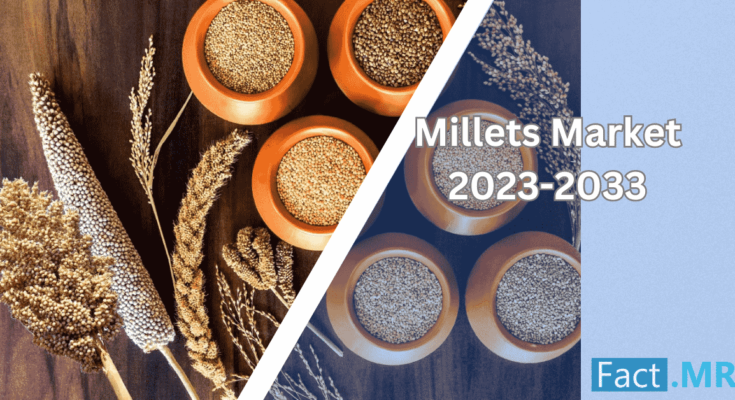Millets are a group of small-seeded grasses that have been cultivated for thousands of years. They are primarily grown in semi-arid regions and have been a staple food in many parts of the world, including Africa, Asia, and parts of Europe. Millets are known for their resilience and ability to thrive even in harsh environmental conditions, making them a valuable crop for farmers in dryland areas. They are highly nutritious, rich in fiber, minerals, and antioxidants, and are gluten-free, making them suitable for individuals with gluten sensitivities. Millets have gained popularity in recent years due to their health benefits, sustainability, and versatility in various culinary applications.
The growing popularity and demand for millets can be attributed to several factors. Firstly, there is a rising awareness among consumers about the importance of healthy eating and the need for nutritious, whole-grain foods. They have gained recognition as a nutritious and gluten-free alternative to traditional grains like wheat and rice. They are rich in fiber, protein, and essential minerals, making them a valuable addition to a balanced diet.
Secondly, the increasing prevalence of lifestyle diseases such as diabetes, obesity, and heart conditions has prompted individuals to seek healthier food options. Millets have shown promise in managing blood sugar levels, aiding weight loss, and promoting cardiovascular health. As a result, health-conscious consumers are actively incorporating millets into their diets.
The global millets market size is valued at US$ 14.22 Billion in 2023 and is projected to reach US$ 23.83 Billion by 2033 as reported by Fact.MR’s recent report.
Furthermore, the sustainability aspect of millet has gained attention. Millets require fewer resources like water and fertilizers compared to other crops, making them environmentally friendly and suitable for cultivation in dryland regions. This aligns with the growing global focus on sustainable agriculture practices and the need to conserve natural resources.
The food industry has also recognized their potential and has started incorporating them into various food products. Millet-based snacks, bread, pasta, and other processed foods are becoming more widely available, catering to the increasing demand for healthier and gluten-free options.
Health Benefits of Millets
– Impressive nutritional profile: Millets are rich in dietary fiber, protein, vitamins, and minerals such as magnesium, iron, and phosphorus.
– Digestive health: The high fiber content aids digestion, prevents constipation, and promotes satiety, aiding in weight management.
– Blood sugar regulation: Millets have complex carbohydrates that are slowly processed, leading to more stable blood sugar levels and reduced risk of diabetes.
– Cardiovascular benefits: They are low in fat and rich in antioxidants, which help reduce inflammation and oxidative stress, contributing to heart health.
– Gluten-free alternative: Being gluten-free, makes them suitable for individuals with gluten sensitivities or celiac disease.
– Sustained energy: They provide sustained energy due to their slow-digesting carbohydrates, making them ideal for athletes and active individuals.
– Healthy skin and hair: The vitamins and minerals in millets contribute to maintaining healthy skin and hair.
– Nutritional powerhouse: Millets are packed with essential nutrients like B vitamins, potassium, and zinc, which support overall health and well-being.
– Weight management: The high fiber content in millets helps promote feelings of fullness, aiding in weight control and preventing overeating.
– Gut health: Contain prebiotics, which nourish the beneficial bacteria in the gut and improve digestion and immune function.
– Disease prevention: Regular consumption of millets has been associated with a reduced risk of chronic conditions like heart disease, type 2 diabetes, and certain types of cancer.
Future Scope
They have gained significant attention in recent years due to their nutritional benefits, sustainability, and adaptability to diverse climatic conditions. The future scope of millets is promising and encompasses various areas:
1. Nutrition and Health: Millets are known for their high nutritional value, including a rich content of fiber, protein, vitamins, and minerals. As people become more health-conscious and seek alternatives to refined grains, they offer a compelling option. The future scope involves increased research and awareness regarding the health benefits, leading to their incorporation into mainstream diets and the development of millet-based functional foods.
2. Sustainable Agriculture and Climate Resilience: Millets are highly resilient crops that require fewer inputs like water, fertilizers, and pesticides compared to other major grains. They can thrive in diverse agro-climatic conditions, including drought-prone areas. The future scope involves promoting them as a sustainable and climate-resilient crop, contributing to food security, and mitigating the impact of climate change on agriculture.
3. Food Security and Rural Development: Millets have been traditionally cultivated in many regions, particularly in developing countries, and play a crucial role in food security for marginalized communities. The future scope involves supporting and promoting millet farming as a means of rural development, income generation, and poverty alleviation. This can be achieved through policies that incentivize millet cultivation, market development, and value chain enhancement.
4. Culinary Innovation and Consumer Demand: As millets gain popularity, there is a growing scope for culinary innovation and diversification of millet-based products. This includes the development of millet-based snacks, bakery products, breakfast cereals, and ready-to-eat meals. Meeting the evolving consumer demand for healthy, sustainable, and gluten-free options presents a significant opportunity in the future.
5. International Trade and Export Potential: Millets have the potential for increased international trade and export opportunities. As global awareness of their nutritional benefits grows, there is a scope for promoting millet as a unique and healthy grain option in international markets. This can contribute to economic growth and foreign exchange earnings for countries that cultivate and export.
Conclusion
The future of millets holds immense potential across various sectors. From their nutritional benefits and climate resilience to their contribution to sustainable agriculture and rural development, millets are poised to play a significant role in addressing global challenges such as food security, health, and environmental sustainability. As consumer demand for healthy and sustainable food options continues to rise, culinary innovation and international trade prospects are also promising. With continued research, investment, and policy support, they have the opportunity to transform the food and agriculture landscape, offering a diverse and resilient solution for a healthier and more sustainable future.
Read More:
- Power of Food Vacuum Drying Machine: Changing the World of Food Preservation, Innovatively in 2023
- Demand for Bamboo Shoots: The Green Gold That’s Creating Future Millionaires Overnight
- The Flourishing Vegan Egg Market: A Wholesome Alternative Revolution




